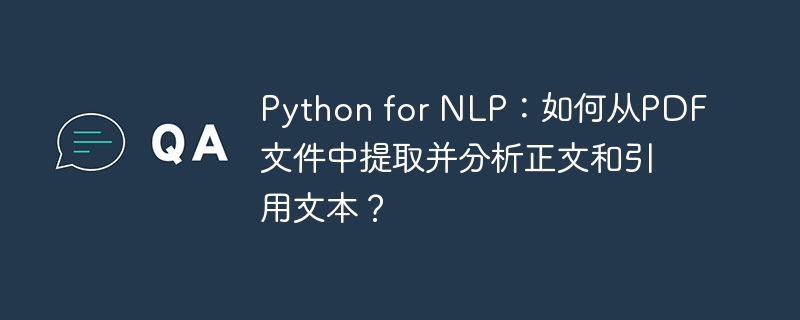 Backend Development
Backend Development
 Python Tutorial
Python Tutorial
 Python for NLP: How to extract and analyze body and quote text from PDF files?
Python for NLP: How to extract and analyze body and quote text from PDF files?
Python for NLP: How to extract and analyze body and quote text from PDF files?

Python for NLP: How to extract and analyze body and quote text from PDF files?
Introduction:
The increasing amount of text data makes Natural Language Processing (NLP) increasingly important in various fields. Today, many academic research and industry projects use PDF files as the primary text source. Therefore, extracting and analyzing main and quoted text from PDF files becomes very critical. This article explains how to achieve this using Python and provides detailed code examples.
Step One: Install the Necessary Libraries
Before we start, we need to install some commonly used Python libraries. They can be easily installed using the pip command. Run the following command in the command line to install the required libraries:
pip install PyPDF2 pip install nltk
Step 2: Load the PDF file
In Python, we can use the PyPDF2 library to read PDF files. The code below demonstrates how to load a PDF file named "sample.pdf".
import PyPDF2
# 打开PDF文件
pdf_file = open('sample.pdf', 'rb')
# 创建一个PDF阅读器对象
pdf_reader = PyPDF2.PdfReader(pdf_file)
# 获取PDF文件中的页数
num_pages = pdf_reader.numPages
# 遍历每一页并获取文本内容
text_content = ""
for page in range(num_pages):
page_obj = pdf_reader.getPage(page)
text_content += page_obj.extract_text()
# 关闭PDF文件
pdf_file.close()Step 3: Extract body and quoted text
Once we have successfully loaded the PDF file, the next task is to extract the body and quoted text from it. In this example, we will use regular expressions to match body and quote text. Also, we will use the nltk library for text processing.
import re
import nltk
from nltk.tokenize import sent_tokenize
# 定义一个函数来提取正文和引用文本
def extract_text_sections(text_content):
# 根据正则表达式匹配正文和引用文本
pattern = r'([A-Za-z][^
.,:]*(.(?!.))){10,}'
match_text = re.findall(pattern, text_content)
# 提取引用文本The above is the detailed content of Python for NLP: How to extract and analyze body and quote text from PDF files?. For more information, please follow other related articles on the PHP Chinese website!

Hot AI Tools

Undresser.AI Undress
AI-powered app for creating realistic nude photos

AI Clothes Remover
Online AI tool for removing clothes from photos.

Undress AI Tool
Undress images for free

Clothoff.io
AI clothes remover

Video Face Swap
Swap faces in any video effortlessly with our completely free AI face swap tool!

Hot Article

Hot Tools

Notepad++7.3.1
Easy-to-use and free code editor

SublimeText3 Chinese version
Chinese version, very easy to use

Zend Studio 13.0.1
Powerful PHP integrated development environment

Dreamweaver CS6
Visual web development tools

SublimeText3 Mac version
God-level code editing software (SublimeText3)

Hot Topics
 How to solve the permissions problem encountered when viewing Python version in Linux terminal?
Apr 01, 2025 pm 05:09 PM
How to solve the permissions problem encountered when viewing Python version in Linux terminal?
Apr 01, 2025 pm 05:09 PM
Solution to permission issues when viewing Python version in Linux terminal When you try to view Python version in Linux terminal, enter python...
 How to avoid being detected by the browser when using Fiddler Everywhere for man-in-the-middle reading?
Apr 02, 2025 am 07:15 AM
How to avoid being detected by the browser when using Fiddler Everywhere for man-in-the-middle reading?
Apr 02, 2025 am 07:15 AM
How to avoid being detected when using FiddlerEverywhere for man-in-the-middle readings When you use FiddlerEverywhere...
 How to teach computer novice programming basics in project and problem-driven methods within 10 hours?
Apr 02, 2025 am 07:18 AM
How to teach computer novice programming basics in project and problem-driven methods within 10 hours?
Apr 02, 2025 am 07:18 AM
How to teach computer novice programming basics within 10 hours? If you only have 10 hours to teach computer novice some programming knowledge, what would you choose to teach...
 How to efficiently copy the entire column of one DataFrame into another DataFrame with different structures in Python?
Apr 01, 2025 pm 11:15 PM
How to efficiently copy the entire column of one DataFrame into another DataFrame with different structures in Python?
Apr 01, 2025 pm 11:15 PM
When using Python's pandas library, how to copy whole columns between two DataFrames with different structures is a common problem. Suppose we have two Dats...
 How does Uvicorn continuously listen for HTTP requests without serving_forever()?
Apr 01, 2025 pm 10:51 PM
How does Uvicorn continuously listen for HTTP requests without serving_forever()?
Apr 01, 2025 pm 10:51 PM
How does Uvicorn continuously listen for HTTP requests? Uvicorn is a lightweight web server based on ASGI. One of its core functions is to listen for HTTP requests and proceed...
 How to handle comma-separated list query parameters in FastAPI?
Apr 02, 2025 am 06:51 AM
How to handle comma-separated list query parameters in FastAPI?
Apr 02, 2025 am 06:51 AM
Fastapi ...
 How to solve permission issues when using python --version command in Linux terminal?
Apr 02, 2025 am 06:36 AM
How to solve permission issues when using python --version command in Linux terminal?
Apr 02, 2025 am 06:36 AM
Using python in Linux terminal...
 How to get news data bypassing Investing.com's anti-crawler mechanism?
Apr 02, 2025 am 07:03 AM
How to get news data bypassing Investing.com's anti-crawler mechanism?
Apr 02, 2025 am 07:03 AM
Understanding the anti-crawling strategy of Investing.com Many people often try to crawl news data from Investing.com (https://cn.investing.com/news/latest-news)...





